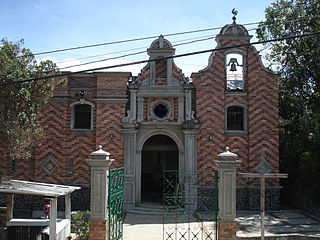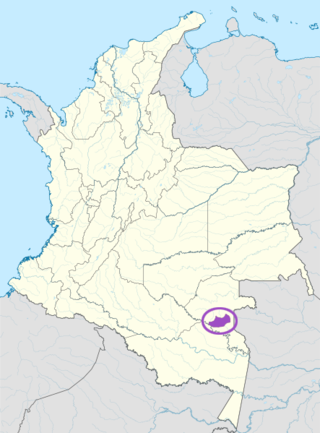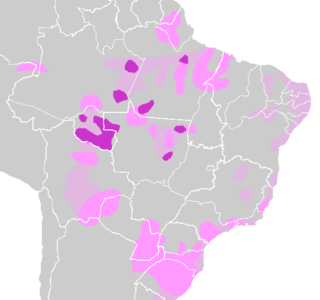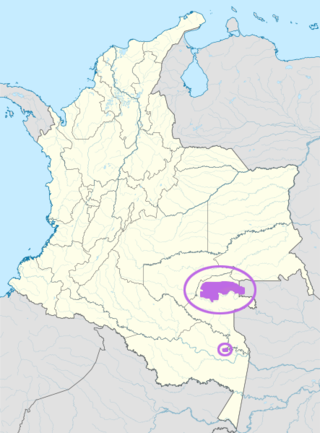Related Research Articles

Shamanism or samanism is a religious practice that involves a practitioner interacting with the spirit world through altered states of consciousness, such as trance. The goal of this is usually to direct spirits or spiritual energies into the physical world for the purpose of healing, divination, or to aid human beings in some other way.

The Arawak are a group of indigenous peoples of northern South America and of the Caribbean. Specifically, the term "Arawak" has been applied at various times from the Lokono of South America to the Taíno, who lived in the Greater Antilles and northern Lesser Antilles in the Caribbean. All these groups spoke related Arawakan languages.
Exogamy is the social norm of mating or marrying outside one's social group. The group defines the scope and extent of exogamy, and the rules and enforcement mechanisms that ensure its continuity. One form of exogamy is dual exogamy, in which two groups continually intermarry with each other.

Vaupés is a department of Southeastern Colombia in the jungle covered Amazonía Region. It is located in the southeast part of the country, bordering Brazil to the east, the department of Amazonas to the south, Caquetá to the west, and Guaviare, and Guainía to the north; covering a total area of 54,135 km2. Its capital is the town of Mitú. As of 2018, the population was 40,797, making it the least populous department in Colombia.

Gerardo Reichel-Dolmatoff was an Austrian anthropologist and archaeologist. He is known for his fieldwork among many different Amerindian cultures such as in the Amazonian tropical rainforests, and also among dozens of other indigenous groups in Colombia in the Caribbean Coast, as well as others living in the Pacific Coast, Llanos Orientales, and in the Andean and inter-Andean regions (Muisca) as well as in other areas of Colombia, and he also did research on campesino societies. For nearly six decades he advanced ethnographic and anthropological studies, as well as archeological research, and as a scholar was a prolific writer and public figure renowned as a staunch defender of indigenous peoples. Reichel-Dolmatoff has worked with other archaeologists and anthropologists such as Marianne Cardale de Schrimpff, Ana María Groot, Gonzalo Correal Urrego and others. He died 17 May 1994 in Colombia.

Tucanoan is a language family of Colombia, Brazil, Ecuador, and Peru.

The Nadahup languages, also known as Makú (Macú) or Vaupés–Japurá, form a small language family in Brazil, Colombia, and Venezuela. The name Makú is pejorative, being derived from an Arawakan word meaning "without speech". Nadahup is an acronym of the constituent languages.

The Urarina are an indigenous people of the Peruvian Amazon Basin (Loreto) who inhabit the valleys of the Chambira, Urituyacu, and Corrientes Rivers. According to both archaeological and historical sources, they have resided in the Chambira Basin of contemporary northeastern Peru for centuries. The Urarina refer to themselves as Kachá, while ethnologists know them by the ethnonym Urarina.
The Hupda are an Amazonian indigenous people who live in Brazil and Colombia. They speak the Hup language.

The Tucano people are a group of Indigenous South Americans in the northwestern Amazon, along the Vaupés River and the surrounding area. They are mostly in Colombia, but some are in Brazil. They are usually described as being made up of many separate tribes, but that oversimplifies the social and linguistic structure of the region.

The Kogi, or Cogui, or Kágaba, meaning "jaguar" in the Kogi language, are an indigenous group that resides in the Sierra Nevada de Santa Marta mountains in northern Colombia. Their culture has continued since the Pre-Columbian era.
The Cubeo are an ethnic group of the Vaupés Department (Colombia). Cubeo is a generic name that is used in local Spanish and appears in the literature in reference to a social and linguistic group. Although the term does not have any meaning in their language, the Cubeo refer to themselves by that name in interactions with others. There is no common native name, aside from referring to themselves as "people" (pâmiwâ) or, more precisely, "my people" (jiwa). An individual's social identification is based on his or her adscription to a mythical clan forebear whose name is used as an eponym.

Barasana is one of the various languages spoken by the Indigenous peoples of the Americas belonging to the Amazonian region, specifically in Colombia. It belongs to the Eastern branch of the Tucanoan language family. The people who speak the language are also known as the Barasana. The population of its native speakers is about 1,990 according to a census taken in 1993. Native speakers' tribes are spread out among the Pira Paraná River in Colombia and the banks of the Vaupés River Basin.

Guanano (Wanano), or Piratapuyo, is a Tucanoan language spoken in the northwest part of Amazonas in Brazil and in Vaupés in Colombia. It is spoken by two peoples, the Wanano and the Piratapuyo. They do not intermarry, but their speech is 75% lexically similar.

Amazonian languages is the term used to refer to the indigenous languages of "Greater Amazonia." This area is significantly larger than the Amazon and extends from the Atlantic coast all the way to the Andes, while its southern border is usually said to be the Paraná. The region is inhabited by societies that share many cultural traits but whose languages are characterized by great diversity. There are about 330 extant languages in Greater Amazonia, almost half of which have fewer than 500 speakers. Meanwhile, only Wayuu has greater than 100,000 speakers. Of the 330 total languages, about fifty are isolates, while the remaining ones belong to about 25 different families. Most of the posited families have few members. It is this distribution of many small and historically unrelated speech communities that makes Amazonia one of the most linguistically diverse regions in the world. The precise reasons for this unusual diversity have not yet been conclusively determined, but Amazonian languages seem to have had fewer than 10,000 native speakers even before the invasion of European colonists wrought havoc on the societies by which they were spoken. Despite the large-scale diversity, the long-term contact among many of the languages of Greater Amazonia has created similarities between many neighboring languages that are not genetically related. Most indigenous Amazonian people today are bilingual or even monolingual in English, Spanish, Portuguese, French or Dutch and many Amazonian languages are endangered as a result.
Irving Goldman was an American anthropologist, known for his acute ability to reconstruct the worldviews and systems of thought of the indigenous peoples whose lives and thought he analysed in several major works, some now regarded as classics in the field of anthropology.

The Cubeo language is the language spoken by the Cubeo people in the Vaupés Department, the Cuduyari and Querarí Rivers and their tributaries in Colombia, and in Brazil and Venezuela. It is a member of the central branch of the Tucanoan languages. Cubeo has borrowed a number of words from the Nadahup languages, and its grammar has apparently been influenced by Arawak languages. The language has been variously described as having a subject–object–verb or an object–verb–subject word order, the latter very rare cross-linguistically. It is sometimes called Pamiwa, the ethnic group's autonym, but it is not to be confused with the Pamigua language, sometimes called Pamiwa.

Yucuna (Jukuna), also known as Matapi, Yucuna-Matapi, and Yukunais, is an Arawakan language spoken in several communities along the Mirití-Paraná River in Colombia. Extinct Guarú (Garú) was either a dialect or a closely related language. Yucuna is a polysynthetic language, and it uses SVO word order.
Shamanism is a religious practice present in various cultures and religions around the world. Shamanism takes on many different forms, which vary greatly by region and culture and are shaped by the distinct histories of its practitioners.
The Bará are an indigenous people originating from the northwest of the Amazon rainforest, which lives in the headwaters of the Tiquié River, above the village of Trinidad and in the upper Igarapé Inambú and the upper Colorado and Lobo.
References
- Wilbert, Johannes; Levinson, David (1994). Encyclopedia of World Cultures. Volume 7: South America. Boston: G. K. Hall. ISBN 0-8161-1813-2
- Aĭkhenvald, Aleksandra Yurievna, Language contact in Amazonia. Oxford University Press, 2002 ISBN 0-19-925785-X
- Bignell, Paul ‘The beckoning silence: Why half of the world's languages are in serious danger of dying out’, The Independent, 13 December 2009
- Brüzzi Alves da Silva, A civilização indígena do Uaupés: observações antropológicas etnográficas e sociológicas, (Centro de Pesquisas de Iauareté, São Paulo, 1962), 2nd.ed. LAS, 1977
- Conselho Indigenista Missionário
- Donkin, R.A. 'The Peccary', in Transactions, American Philosophical Society, (vol. 75), Part 5, 1985 pp. 1–152
- Goldman, Irving ‘The Tribes of the Uapes-Caqueta Region,’ in J.W.Steward (ed.) Handbook of South American IndiansSmithsonian Institution, Bureau of American Ethnology, Bulletin 143, 3, Washington D.C. 1948 pp. 763–798
- Goldman, Irving, The Cubeo Indians of the Northwest Amazon, (1963) University of Illinois Press, 2nd.ed. 1979 ISBN 0-252-00770-0
- Gomez-Imbert,Elsa 'Conceptual categories and linguistic classification,' in John J. Gumperz, Stephen C. Levinson (eds.) Rethinking Linguistic Relativity, Cambridge University Press, 1996 ISBN 978-0-521-44890-1
- Hill, Jonathan David, History, power, and identity: ethnogenesis in the Americas, 1492-1992, University of Iowa Press, 1996 ISBN 0-87745-547-3
- Hill, Jonathan David Made-from-bone:: trickster myths, music, and history from the Amazon, University of Illinois Press, 2008 ISBN 0-252-07570-6
- Hugh-Jones, Christine, From the Milk River: Spatial and temporal processes in Northwest Amazonia, Cambridge University Press, Cambridge 1979 ISBN 0-521-35889-2,
- Hugh-Jones, Stephen, The Palm and the Pleiades: Initiation and Cosmology in Northwest Amazonia, Cambridge University Press, Cambridge 1979 ISBN 0-521-21952-3
- Stephen Hugh-Jones, ‘Shamans, Prophets, Priests and Pastors,’ in Nicholas Thomas & Caroline Humphrey (eds.), Shamanism, history, and the state, University of Michigan Press, (1994)1996 pb. pp. 32–75 ISBN 0-472-08401-1
- Gomez-Imbert, Elsa, ‘Conceptual categories and linguistic classification’, in John Joseph Gumperz, Stephen C. Levinson (eds.) Rethinking linguistic relativity, Cambridge University Press, 1996 Cambridge University Press, 1996 pp. 438–469 ISBN 0-521-44890-5
- Gomez-Imbert, Elsa, & Kenstowicz, Michael, ‘Barasana Tone and Accent,’ in International Journal of American Linguistics, Vol. 66, No. 4 (Oct., 2000), pp. 419–463
- Jackson, Jean Elizabeth, ‘Language Identity of the Vaupés Indians,’ in Richard Bauman, Joel Sherzer (eds.) Explorations in the ethnography of speaking, Cambridge University Press, 1974 ch.2 pp. 50–64
- Jackson, Jean Elizabeth, The fish people: linguistic exogamy and Tukanoan identity in northwest Amazonia, Cambridge University Press, 1983, ISBN 0-521-27822-8
- Koch-Grünberg, Theodor, Zwei Jahre unter den Indianern: Reisen in Nordwest Brasilien 1903/1903, Wasmuth Verlag, Berlin, 2 vols. 1909/1910
- Langdon, Thomas Allen, Food restrictions in the medical system of the Barasana and Taiwano Indians of the Colombian Northwest Amazon, (Doctoral thesis, Tulane University 1975) UMI, 1978
- Moseley, Christopher (ed.), Encyclopedia of the world's endangered languages, Routledge, 2007 ISBN 0-7007-1197-X
- Myers, O. Gene, The significance of children and animals: social development and our connections to other species, Purdue University Press (1998), 2nd.rev.ed. 2007 ISBN 1-55753-429-2
- Reichel-Dolmatoff, Gerardo, ‘Review of The Cubeo: Indians of the Northwest Amazon by Irving Goldman ,’ in American Anthropologist, New Series, Vol. 65, No. 6 (Dec., 1963), pp. 1377–1379
- Reichel-Dolmatoff, Gerardo, Amazonian Cosmos: The Sexual and Religious Symbolism of the Tukano Indians, University of Chicago Press, Chicago and London 1971 ISBN 0-226-70731-8
- Reichel-Dolmatoff, Gerardo, Shamanism and art of the eastern Tukanoan Indians: Colombian northwest Amazon, BRILL, 1987 ISBN 90-04-08110-0
- Reichel-Dolmatoff, Gerardo, Yuruparí: studies of an Amazonian foundation myth, Harvard University Center for the Study of World Religions, 1996 ISBN 0-945454-08-2
- Rubio, François Correa . Por el Camino de la Anaconda Remedio, Univ. Nacional de Colombia, 1996
- Schultes, Richard Evans & Hofmann, Albert, Plants of the Gods: Origins of Hallucinogenic use, Hutchinson, London 1980 ISBN 0-09-141600-0
- Shermer, Michael, In Darwin's shadow: the life and science of Alfred Russel Wallace : a biographical study on the psychology of history, Oxford University Press US, 2002 ISBN 0-19-514830-4
- Wright, Robin M. & Hill, Jonathan D ‘Venancio Kamiko: Wakuenai Shaman and Messiah,’ in E. Jean Langdon and. Gerhard Baer, (eds.) Portals of Power: : Shamanism in South America, University of New Mexico Press, 1992 1992 pp. 257–286.
- Znamenski, Andrei A. The beauty of the primitive: shamanism and Western imagination, Oxford University Press US, 2007 ISBN 0-19-517231-0